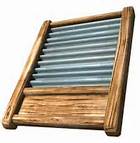Moulder Knife Marks Per Inch
Mar 31st 2013
 Improperly set moulder feed rates can cause a Washboard finish that is often invisible until stain is applied.
Improperly set moulder feed rates can cause a Washboard finish that is often invisible until stain is applied.
Here is a table published by Wisconsin Knife Works, Inc. summarizing the results of their study on the number of knife marks per inch required to produce a stain-ready finish on various wood types.
This table shows the Knife Marks per Inch ranges generally recommended for wood species commonly used in manufacturing Cabinet Doors.
Knife Marks per Inch required for a “Stain Ready” finish
| Alder | 10 | to |
| Ash | 11 | to |
| Beech | 12 | to |
| Birch | 8 | to |
| Cherry | 11 | to |
| Hickory | 12 | to |
| Mahogany | 14 | to |
| Maple | 12 | to |
| Oak | 12 | to |
| Pine | 9 | to |
This study applies very well to machining cabinet door stile and rail stock through a modern 5-head moulder.
The feed rate of the moulder needs to be set within the optimum range for the wood type being run. To fast a feed rate will lower the knife marks per inch and produce a finish with a washboard finish that will become visible under some stains or finishing applications. Fast feed rates can also produce chipping in the detail cuts, which may not be removable with sanding. While operating moulders at faster rates certainly increases moulder throughput, it comes at the expense of requiring additional sanding prep on the part of the cabinet shop finisher.
To slow a feed rate will produce knife marks per inch higher than the recommended level. This can glaze the surface or even produce burns.
At CabinetDoors.Com we adjust our moulders to run at the mid-point of the recommended speed range for each wood we process. This produces a finished cabinet door that is considered “stain ready” for the vast majority of finishes used by custom cabinet makers across the country.
Proper moulder setup is even more important with the detailed patterns used in some Mitered Cabinet Doors. Unlike traditional Cope & Stick doors which have the faces wide-belt sanded, most mitered doors cannot be wide-belt sanded on the face. These designs require special handling and a separate hand-sanding operation to assure a stain-ready product is delivered to the end user.
At CabinetDoors.Com, we have tailored our manufacturing process toward providing a product that reduces the labor requirements of the cabinet shop and supplies an unfinished cabinet door that is truly “Stain Ready”.
Return to the Cabinet Doors Blog.
Visit the Cabinet Doors website.

